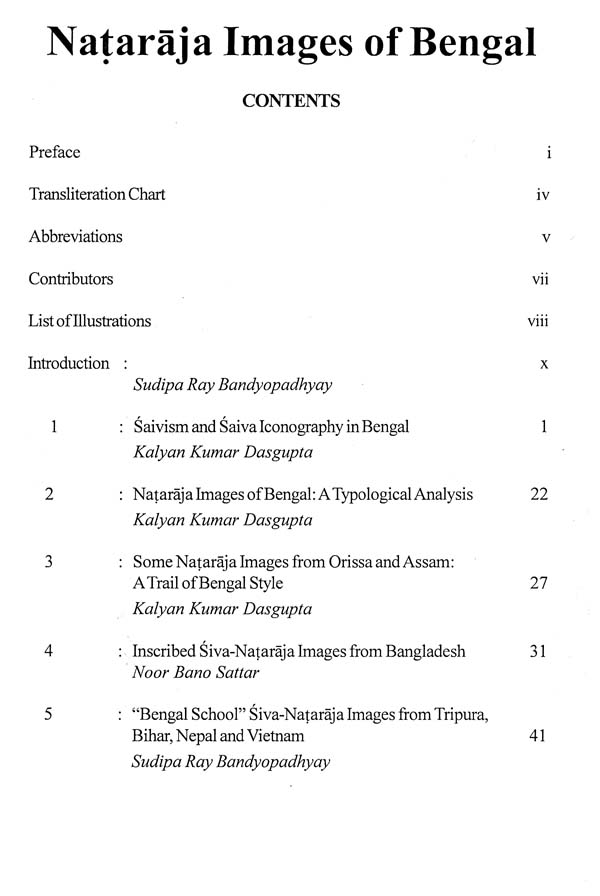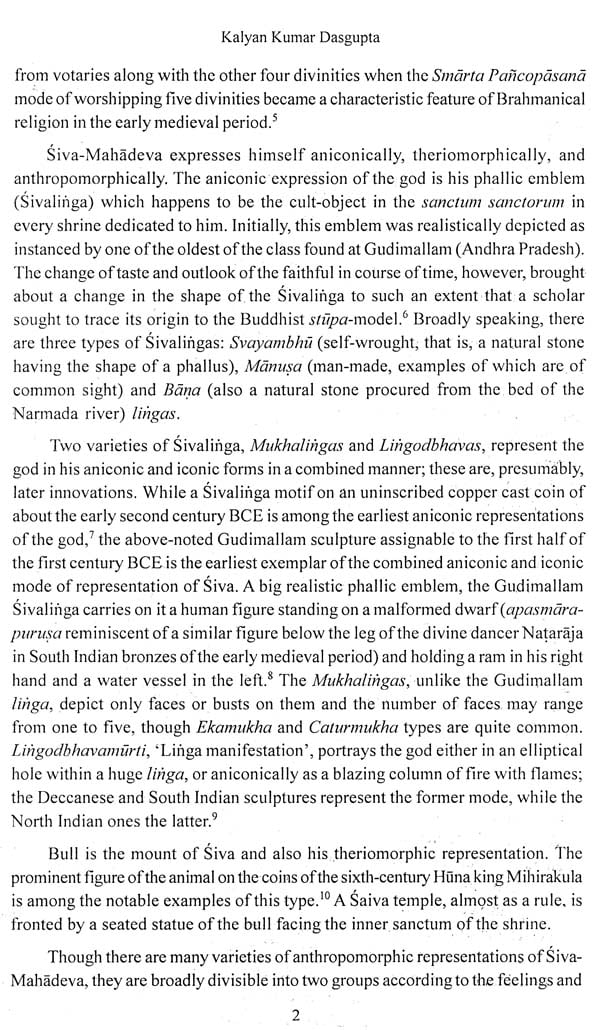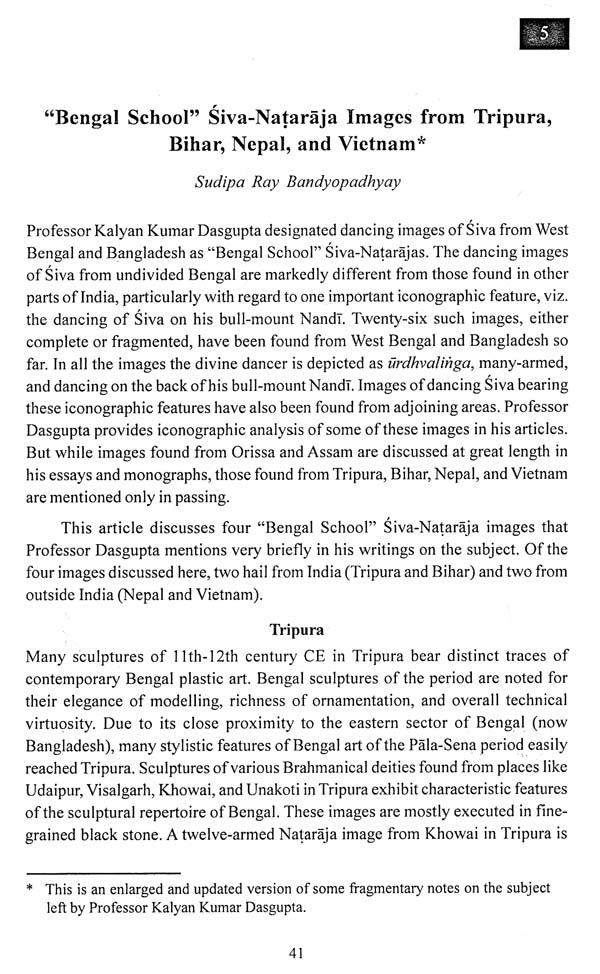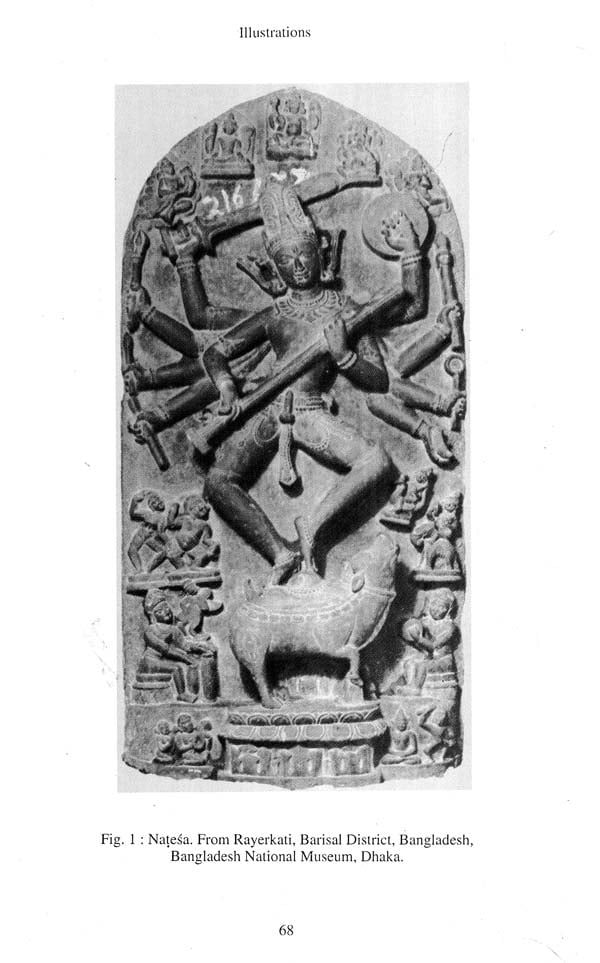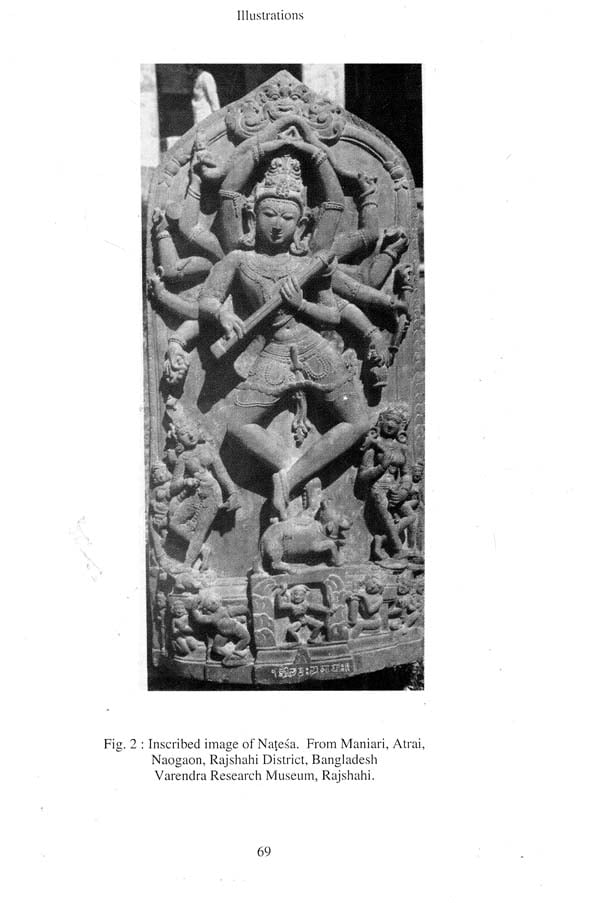
Nataraja Images Of Bengal
Book Specification
| Item Code: | NAX054 |
| Author: | Sudipa Ray Bandyopadhyay |
| Publisher: | University of Calcutta |
| Language: | English |
| Edition: | 2017 |
| ISBN: | 9788193712108 |
| Pages: | 98 (18 B/W Illustrations) |
| Cover: | PAPERBACK |
| Other Details | 9.50 X 6.00 inch |
| Weight | 330 gm |
Book Description
The book Nataraja Images of Bengal was first conceived by the late Kalyan Kumar Dasgupta, Rani Bagiswari Chair Professor, Department of Ancient Indian History and Culture, University of Calcutta. He could not complete the book due to his sudden demise in 1996. The present book brings to fruition Professor Dasgupta's unfinished project through a collection of essays by Professor Dasgupta and other scholars-dealing with the iconography of Siva-Nataraja images that have been found from different parts of undivided Bengal, i.e. West Bengal and Bangladesh. Bengal produced a special type of Siva-Nataraja image that is very different from the Siva-Nataraja images abundantly seen in South India. The book begins with an 'Introduction' on the subject followed by a chapter offering an exhaustive typological analysis of the Nataraja images of the Bengal School. The next three chapters - 'Some Nataraja Images from Orissa and Assam: A Trail of Bengal Style', 'Inscribed Nataraja Images of Bengal', and `Nataraja Images from Tripura, Bihar, Nepal, and Vietnam' - offers various perspectives on the subject. The fifth and final chapter titled, 'Dancing Deities on Stone Medallions: Controversy over Identity' deals with an issue that has long been the subject of debate among art historians. The book contains a good number of illustrations.
Nataraja Images of Bengal brings together a collection of essays on the Siva-Nataraja images of Bengal. Bengal Siva-Nataraja images was a subject that deeply fascinated the late Kalyan Kumar Dasgupta, Rani Bagiswari Chair Professor, Department of Ancient Indian History and Culture, University of Calcutta and also a distinguished alumnus of the same. He even wanted to publish a full-length book on the subject someday, but his sudden demise in 1996 left this dream unfulfilled. Finally, after over two decades of his demise, we have been able to bring out this collection of essays under the aegis of the University of Calcutta For me personally as well as the other contributors to this anthology being associated with this project was a matter of great joy and honour.
Quite some time back Professor Dasgupta's sister, Dr. Gayatri Sen Majumdar handed me a typewritten manuscript of what was supposedly the book on Siva-Nataraja images of Bengal that Professor Dasgupta wanted to publish. Dr. Gayatri Sen Majumdar requested me to edit the manuscript and make it ready for publication. I gladly accepted the offer because it gave me an opportunity to express my gratitude to Professor Dasgupta, who was my teacher and later my Ph.D. Supervisor. Besides, as a present teacher of the department of AIHC it was also a great opportunity for me to express my gratitude to a former distinguished teacher of the department in its centenary year.
The task of editing the manuscript, however, turned out to be a more difficult job than I thought it would be. The central part of the manuscript was missing and some portions of it had already been published in two volumes of Kalyan Bharati, a Journal of Ancient Indian History, dedicated to the memory of Professor Dasgupta. Kalyan Bharati has been appearing annually under the Managing Editorship of Dr. Gayatri Sen Majumdar since its inception. In the circumstances, the only option that I had was to extract materials from the manuscript and recast them as independent articles. Taking into account the various important researches that have taken place in the field in the last twenty years, I also had to update much of the information in the manuscript. I could finally extract materials that could be recast into three independent articles. To update the book with insights offered by new researches in the field, I and my researcher friends and students had to contribute four articles. The book, in its present form, thus embodies the reflections and researches of three generations of scholars.
I am thankful to many people who helped me in various ways in bringing out this book. I am especially grateful to Professor Enamul Hague, Chairman, International Centre for Study of Bengal Art, Dhaka, Bangladesh for allowing me to reproduce of some photographs from his book Bengal Sculptures: Hindu Iconography up to 1250 A.D. and to my friend Professor Mokammal H. Bhuiyan of Jahangirnagar University, Dhaka, Bangladesh for giving me the permission to reproduce some photographs of Bengal Siva-Nataraja images from his edited volume Studies in South Asian Heritage for publication in this book. Professor Sukla Das, formerly of Jadavpur University, constantly encouraged me in this gurupranam task and regularly inquired about the book's progress. My sincere thanks to her.
The publication of this book would not have been possible without the help and cooperation of the authorities of the University of Calcutta. I wish to express my sincere thanks to the Honourable Vice Chancellor, Pro-Vice Chancellor (Academic Affairs), and Pro-Vice Chancellor (Business Affairs & Finance), the Registrar for providing the necessary permission and financial assistance. I also wish to thank the Superintendent, Calcutta University Press and his efficient team for their help and technical assistance.
I am thankful to all the museums that offered me ready access to their collection for information and data verification. Among them, I specially thank Asutosh Museum of Indian Art, University of Calcutta; Dakshin Dinajpur District Museum, Balurghat; Vishnupur Sahitya Parishad Museum, Vishnupur; Bidisha Museum, Purba Medinipur; Indian Museum, Kolkata; Assam State Museum, Guwahati, Assam; and Bangladesh National Museum, Dhaka, Bangladesh. I am also thankful to the staff of the libraries of the Ramakrishna Mission Institute
of Culture, Golpark; the Alipur Campus Library of the University of Calcutta; the Indian Museum Library; and the library of the Asiatic Society, Kolkata for providing me with the necessary books at short notice.
I also wish to thank Dr. Gayatri Sen Majumdar, the Managing Editor of Kalyan Bharati for providing the necessary permission to reproduce photographs from different volumes of the Journal. Amrita Chakraborty, my Ph.D. scholar, helped me in various ways in preparing the final press copy. Souvik Mondal, my post-graduate student at the Department also helped me in various ways and Rahul Nag, my M. Phil. student and presently a trainee at the Institute of Archaeology under the Archaeological Survey of India, New Delhi provided me the photograph. My thanks to all of them.
I am also grateful to my friend Sri Abhik Das, Sub Divisional Officer, Kandi Sub Division of the District of Murshidabad, West Bengal for providing me the photograph of a rare image of Siva-Nataraja.
Last but not least, I wish to thank my family members, Ms. Kairi Oraon, my daughter Ms. Sattwika Ray, and my husband Dr. Swarup Ray without whose support and encouragement the completion of the book would not have been possible.
On June 18, 2004, a 2 metre tall statue of Siva-Nataraja was unveiled at CERN, the European Organization for Nuclear Research in Geneva. The Government of India presented the statue to CERN in recognition of the research centre's long association with India. In choosing the image of Siva-Nataraja, the Indian government acknowledged the profound significance of the metaphor of Siva's dance for expressing the dynamic nature of subatomic matter. The parallel between Siva's dance and the dance of subatomic particles was first broached by the physicist Fritjof Capra in an article, "The Dance of Shiva: The Hindu View of Matter in the Light of Modern Physics" (1972). He later made Siva's cosmic dance the central metaphor of his book, The Tao of Physics (1975). The plaque instated near the statue at CERN quotes the following passage from Capra's book :
Hundreds of years ago, Indian artists created visual images of dancing Shivas in a beautiful series of bronzes. In our time, physicists have used the most advanced technology to portray the patterns of the cosmic dance. ...The metaphor of the cosmic dance thus unifies ancient mythology, religious art and modern physics.'
The bronze sculptures of Siva-Nataraja have captivated not only physicists like Capra, but scores of Indophiles all over the world for more than a century. Though images of dancing Siva are common all over India, and are known by various names like Natambara, Natabhairava, Natarudra, Nattesvara, Narttesvara, etc., none has drawn as much attention as the south Indian Siva-Nataraja form. One reason for the popularity of this image is of course Ananda K. Coomaraswamy's influential analysis of the image in his famous essay "The Dance of Siva" (1912). Coomaraswamy draws upon Saiva Siddhanta agamas in the essay to explain the symbolism of the ananda tandava dance of Siva-Nataraja: the fire in one of Nataraja's hands signifies cosmic destruction while the drum in the opposite hand signifies the rhythm of creation; the open palm is suggestive of protection and the opposite drooping hand pointing toward the raised foot signifies release from illusion; and the corpulent dwarf that he crushes under his foot personifies ignorance. This is in line with Saiva Siddhanta theology which emphasizes the five-fold action or pancakrtya of Siva -srsti (creation), sthiti (preservation), samhara (destruction), tirobhava (veiling), and anugraha (grace). Thanks to Coomaraswamy's influential analysis of the symbolism of the Siva-Nataraja image, a purely regional image soon acquired a pan-Indian status.
Interestingly, the term `Nataraja', which has now become a kind of shorthand for images of dancing Siva in general, appeared for the first time in the Tamil region only in the thirteenth century CE in an inscription of the Pandyan period. The inscription was discovered in a Siva temple at Tiruvekampattu, near Tondi on the east coast. The inscription mentions that a temple for Natarajesvaramutaiyar was built by one Somanathadeva. The record is dated as during the reign of Cataiyavarman Vikrama Pandya, in A.D. 1241. As far as literary evidence is concerned, Umapati Sivacarya uses the epithet `Nataraja' in the Cekkilar Puranam, dated as A.D. 1300. None of the Sanskrit texts on Chidambaram, down to the thirteenth century, use the term `Nataraja'. It is only after the fifteenth century A.D. that `Nataraja' came to be associated exclusively with Siva as dancer.'
The collection of essays in this book is aimed at shifting this focus from the dancing image of Siva-Nataraja specific to the Tamil region to other images of dancing Siva, particularly those found in the eastern region, viz., West Bengal, Bangladesh, and adjoining areas. These images dating from c. 10th to 12th century CE have remained largely neglected. Though mention of these images can be found in Nalini Kanta Bhattasali's influential early work Iconography of Buddhist and Brahmanical Sculptures in the Dacca Museum and in several articles and monographs by later art historians like Mukhlesur Rahman, A. K. M. Shamsul Alam, Pratapaditya Pal, Gauriswar Bhattacharya, Enamul Haque, Kalyan Kumar Dasgupta, and Susan L. Huntington, attempts to systematically catalogue and study them were undertaken only recently. In this the pioneering efforts of Anna Slaczka deserve special mention.
The Bengal images can be broadly classified into two groups - those with ten arms and those with twelve, though some stray eight-armed images have also been found. Except minor variations, the hand-gestures and attributes in both the ten-armed and twelve-armed varieties generally follow a common pattern. In the ten-armed images, Siva is usually seen with one of his main arms in the gajahasta (elephant-trunk) gesture while the second one is raised. There is a sword (khadga) on the right and a shield (khetaka) on the left in the uppermost pair of arms, and one of the lower left hands holds a skull-bowl (kapala). In the remaining right hands Siva holds a trident (triSula), staff (danda), and spear (Sakti), and on the left there is a skull-staff (khatvanga) and a snake-noose (nagapasa). In the twelve-armed images, the uppermost pair of arms is generally depicted as raised with the hands clasped above the head, the second pair holds a giant snake, and the principal pair holds a vina. However, the two distinctive features that make the Bengal images really unique are the depiction of Siva as ithyphallic and dancing on his vehicle, the bull.'
The iconography of dancing gods and goddesses is discussed in various technical treatises dealing with architecture (vastusastra) and sculpture (silpasastra). While some texts like Sakaladhikara, Sritattvanidhi, Silparatna, Amsumadbhedagama, Mayamata, Manasara, etc. are popular in South India, some like Visnudharmottara, Matsyapurana, Brhatsamhita, Devatamurtipraharana, Silpaprakasa, etc. are popular at the pan-Indian level. Early studies on Hindu iconography like T. A. Gopinath Rao's Elements of Hindu Iconography, Stella Kramrisch's The Hindu Temple, and Jitendra Nath Banerjea's The Development of Hindu Iconography mainly drew upon South Indian Saiva agamas and agama-influenced iconography texts for understanding and interpreting Saiva art. These South Indian texts were frequently deployed to interpret Saiva art of other regions, though such art often predated South Indian Saiva art.
In the case of the Bengal images, however, Matsyapurana, was commonly used as the textual source because the attributes depicted in the ten-armed Bengal images broadly agree with those described in Chapter 259 of the Matsyapurana. It says that Siva should be depicted holding a shield (khetaka), skull-bowl (kapala), snake (naga), and skull-staff (khatvanga) in the left hands, and in the right a sword (khadga), spear (sakti), staff (danda), and trident (trisula). The remaining two hands should show the boon-granting gesture (varadamudra) and a rosary-like rudraksa bracelet (aksavalaya). But the Matsyapurana does not say that Siva should be depicted ithyphallic or dancing on a bull, the two distinctive iconographic features of the Bengal sculptures. All that the Matsyapurana (259.10-11) says is that when Siva is depicted as imitating a dancing posture (nrtyabhinayasamsthitah), he should be made ten-armed and shown wearing the hide of an elephant.
**Contents and Sample Pages**
